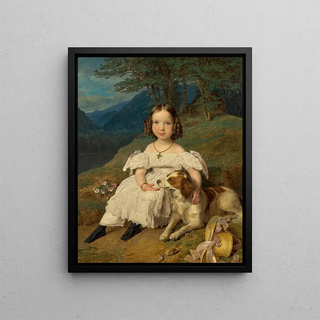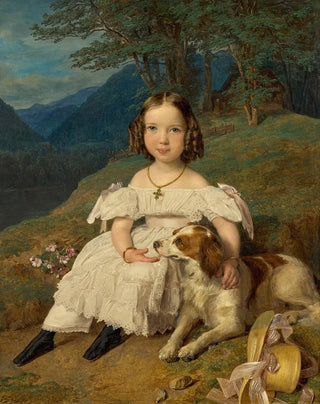Art print | Julia Comtesse Apraxine - Ferdinand Georg Waldmüller


View from behind

Frame (optional)
In the vast panorama of art history, certain works stand out not only for their technique but also for the depth of their subject matter. "Julia Comtesse Apraxine - Ferdinand Georg Waldmüller" is one of those iconic pieces that capture the essence of an era. This painting, depicting the beauty and grace of Countess Julia Apraxine, immerses us in a world where elegance and sophistication blend with palpable intimacy. Through Waldmüller’s gaze, the 19th-century Austrian artist, viewers are invited to discover not only the personality of his model but also the subtleties of a moment frozen in time, where every detail seems to tell a story.
Style and uniqueness of the work
Ferdinand Georg Waldmüller’s style is characterized by a realistic approach, where meticulous observation of human nature and emotions is emphasized. In "Julia Comtesse Apraxine," this attention to detail manifests in the rendering of textures and lights, creating an almost tangible atmosphere. The chosen colors, soft and harmonious, highlight the delicacy of the countess’s face, while her richly detailed clothing evokes a sense of fashion and luxury typical of her status. Waldmüller manages to capture not only the external beauty of his model but also an inner dimension, a reflection on the life and aspirations of the aristocratic woman of his time. This painting, through its composition and lighting, reveals technical mastery that demonstrates the artist’s expertise, while offering viewers a deeply emotional visual experience.
The artist and his influence
Ferdinand Georg Waldmüller is often regarded as one of the pioneers of realism in painting. Trained in the shadow of academicism, he was able to break free and develop a style that is uniquely his own, combining precision and sensitivity. His influence extends well beyond Austria’s borders, affecting generations of artists who saw in him a model of artistic integrity. Waldmüller successfully evolved portraiture, transforming it into a means

Matte finish

View from behind

Frame (optional)
In the vast panorama of art history, certain works stand out not only for their technique but also for the depth of their subject matter. "Julia Comtesse Apraxine - Ferdinand Georg Waldmüller" is one of those iconic pieces that capture the essence of an era. This painting, depicting the beauty and grace of Countess Julia Apraxine, immerses us in a world where elegance and sophistication blend with palpable intimacy. Through Waldmüller’s gaze, the 19th-century Austrian artist, viewers are invited to discover not only the personality of his model but also the subtleties of a moment frozen in time, where every detail seems to tell a story.
Style and uniqueness of the work
Ferdinand Georg Waldmüller’s style is characterized by a realistic approach, where meticulous observation of human nature and emotions is emphasized. In "Julia Comtesse Apraxine," this attention to detail manifests in the rendering of textures and lights, creating an almost tangible atmosphere. The chosen colors, soft and harmonious, highlight the delicacy of the countess’s face, while her richly detailed clothing evokes a sense of fashion and luxury typical of her status. Waldmüller manages to capture not only the external beauty of his model but also an inner dimension, a reflection on the life and aspirations of the aristocratic woman of his time. This painting, through its composition and lighting, reveals technical mastery that demonstrates the artist’s expertise, while offering viewers a deeply emotional visual experience.
The artist and his influence
Ferdinand Georg Waldmüller is often regarded as one of the pioneers of realism in painting. Trained in the shadow of academicism, he was able to break free and develop a style that is uniquely his own, combining precision and sensitivity. His influence extends well beyond Austria’s borders, affecting generations of artists who saw in him a model of artistic integrity. Waldmüller successfully evolved portraiture, transforming it into a means






